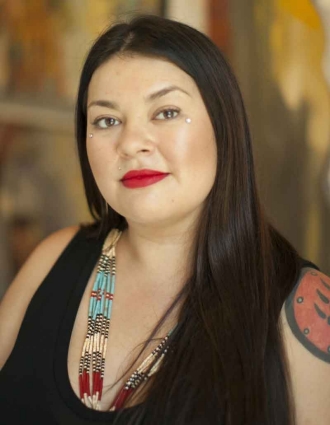Eruoma Awashish holds a Bachelor of Arts (interdisciplinary) from Université du Québec à Chicoutimi. She recently participated in the Bienniale d’art contemporain autochtone “Contemporary Native Art Biennial” (BACA) and in the winter of 2017-2018, she presented an exhibition at the Montreal Fine Arts Museum. Her artistic approach aims to create spaces for dialogue and facilitate understanding of First Nations culture. She grew up in her home community of Opitciwan; she then resided in Wemotaci, but her studio is now based in Pekuakami (Lac-St-Jean), in the Innu community of Mashteuiatsh. Her work is characterized by spirituality, symbolism, and syncretism. She uses and diverts symbols alluding to the catholic religion. For her, it’s a way to regain her own spirituality. « By rejecting the doctrine and all the institutional side of religions, true spirituality emerges. » With these symbols that intersect and clash, her work speaks simultaneously of contrast and diversity, duality and balance, injuries and healings …
Significance of the image
In Iroquois culture, the three sisters (corn, beans and squash) are a symbol of collaboration. They are called the three sisters because they work together to grow. This image is important for First Nations cultures, since drawing inspiration from nature and the land as we value and pass down our traditions and culture is central to our worldview. What’s more, the bear (symbolizing strength), the goose (evoking leadership) and the crow (representing intelligence), remind us how these qualities will help us go higher and further together!
 Photo by: Nadya Kwandibens
Photo by: Nadya Kwandibens